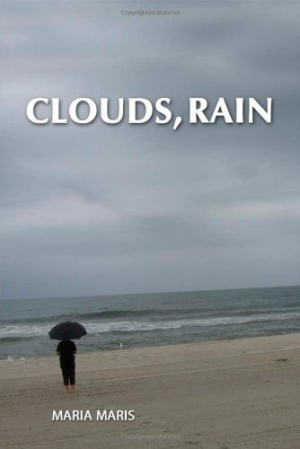
Clouds, Rain
Emotions of loss and images of aging echo throughout most of the poems in Clouds, Rain by Maria Maris. Although the collection is eclectic and sometimes repetitive, a strong voice and visceral language strengthen this beautifully written book.
For the most part, Maris uses rhyme in interesting and imbedded ways, and she creates forms that seem solely hers: “I am treed / outside my lair. / There is a thrumming / in the air / the end of a sound / I cannot hear– / old fear / and new despair.” Unfortunately, more often than not, the rhyming is oversimplified, as with the title poem “Clouds, Rain” where the poet states, “I hope where you have gone / you have the sun. / Here there is none. / Clouds, rain. / And the mirrors fill with pain. / Clouds, rain.” In general, the rhyming poems are a bit lackluster.
That said, the pacing in Clouds, Rain is perfect. Maris pays close attention to line breaks and rhythm. She also masterfully lures her audience into the poems with interesting and unusual images. In the piece “It Was Not So Long Ago,” Maris’ voice shines through with the lines, “And with what grace / I danced / Bolero y danzon / Before my bones were lace.” The poem “Pneumonia I” is another example of the poet’s cleanly crafted lines, especially the moments when she likens the infection to a wild animal.
While Maris is adept at filling her poems with transcendent lines, she packs the space in between her unique images with clichéd phrases that do not uphold the standards set by her otherwise imaginative use of language. Phrases like “ablaze with endless time / and all desire” or “your arms are home” bring the quality of the pieces down considerably.
At times Clouds, Rain can be extremely repetitious, especially with the author’s penchant for pairing the same word for effect. In the poem “Ship Bells,” Maris writes, “While the ship bells ring / Alone, / alone…” Such repetition is seen again in the poem “Clouds, Rain” with, “How long I’ve lain / beside you / still, still.” In fact, this type of repetition is present in most of the poems and even seeps into their titles, as in “Pace, pace.” Readers may question why Maris depends so heavily on one literary device.
When viewed as a whole, Clouds, Rain appears to have so many different styles that it is surprising it was written by only one author. The second to last section, “Arf, Arf,” seems to live separately from the rest of the book. The poems in this part are more humorous and rhythmic, and in some cases seem like a cross between slant poetry and vaudevillian skits. Although entertaining and jovial, they stick out considerably from the rest of the collection. The last section, “Otres Mares,” is written and printed solely in Spanish and also feels strangely out of place because of the lack of translations.
Even so, because of the impressive quality of the language in each section, Clouds, Rain is a worthwhile collection. Its enduring themes and strong voice make the poems accessible and memorable.
Reviewed by
Colby Cedar Smith
Disclosure: This article is not an endorsement, but a review. The publisher of this book provided free copies of the book and paid a small fee to have their book reviewed by a professional reviewer. Foreword Reviews and Clarion Reviews make no guarantee that the publisher will receive a positive review. Foreword Magazine, Inc. is disclosing this in accordance with the Federal Trade Commission’s 16 CFR, Part 255.
